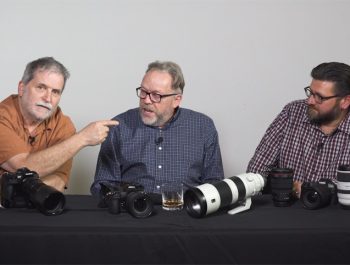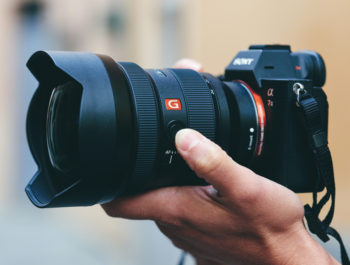Lenses – The Other Half of the Image Quality (IQ) Equation
Part 3 Of A Three-Part Essay On IQ
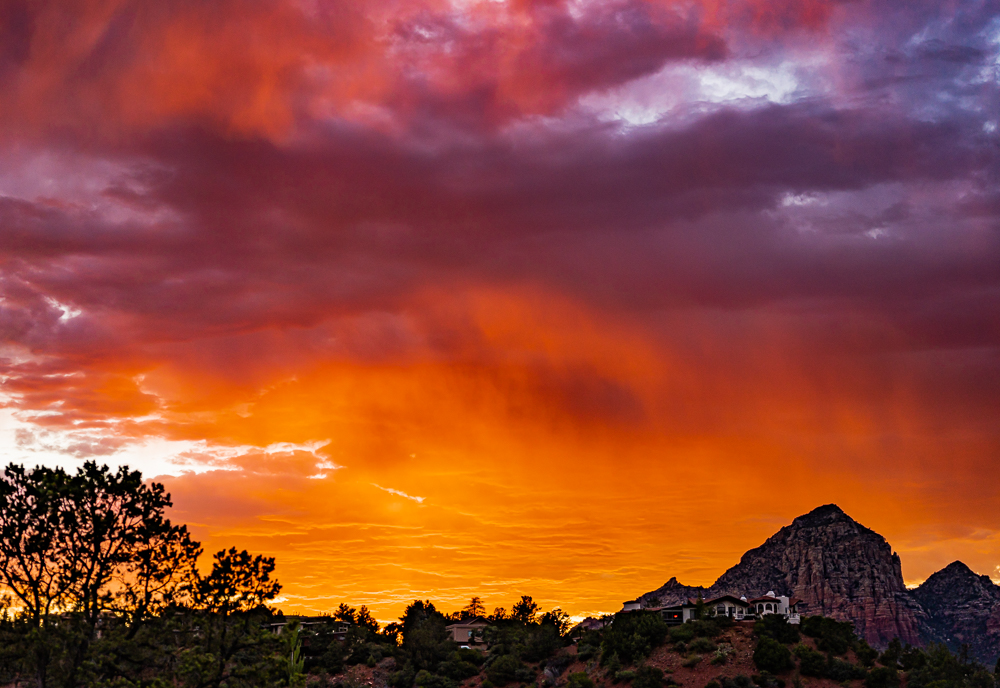
The first two articles in this series were easy for me to write, as the introduction of Sony’s A7r M4 camera brought me to a point I long hoped for after buying my first digital camera in 1995. That event occurred 20 years after attending the G Ray Hawkins Gallery’s Ansel Adams retirement exhibit in Santa Monica, after which I set a goal to achieve maximum “reality” in my own silver landscape images with an abundance of fine detail and rich black and gray tones. Later, when I developed my own color films and prints, color accuracy was added to that mix.
That goal proved largely elusive over the next 20 years, even with a Linhof Master Technica 4×5 camera. Clearly, I was no Ansel Adams. And, the surfeit of bulky equipment interfered with my ability to respond quickly to rapidly changing lighting. So, when I bought my first “D” camera in 1995, an almost pocketable toy with a whopping 0.24 MP output, I knew that someday I would be able to capture scenes more realistically, and without carrying 40 pounds on my back all day.
Some twenty-five years later, with my Sony A7r M4 with its 61 MP sensor in hand, my personal quest was realized, inspiring me to write a 3-part article on Image Quality. Parts I & 2 of this series almost wrote themselves. But, this third part on how lenses impact IQ has proved far more complex and required me to develop a clearer understanding of the specific design and manufacturing challenges to be overcome in producing higher IQ optics. I have logged at least a hundred hours reading articles and treatises on lens design and performance, as there seems to be no end of data and commentary available from lens manufacturers, optical testing services, photo-equipment retailers and photo industry bloggers.
Yet, conclusions have not come easy, as much of the available information is vague, incomplete and sometimes contradictory. The fact is that the technology and art of designing highly corrected lenses has always been closely guarded by manufacturers and designers. And even when information is divulged, it is often limited and difficult to follow. But, eventually I learned enough about lens design constraints and solutions to discuss them comfortably.
A second issue to be overcome was how to cover this topic credibly in a short article and still maintain reader interest? The best approach seems be to provide a general overview supplemented with my personal experience with eight carefully researched lenses that I bought and tested in the field on my Sony A7r M4. To hopefully avoid misconceptions, this article is being written with the following caveats.
1. Only IQ of RAW digital image files is being addressed. No reference to image quality of prints will be made, as that introduces a whole additional set of variables.
2. Though this article will attempt to provide a simple snapshot of current objectives, challenges, achievements and trends within the photographic equipment industry, more specific comment will be confined to my direct experience and observations regarding the lenses that I bought in the hopes of extracting maximum performance from my Sony A7r M4 camera. Most test sites consider lens comparisons most meaningful when the lenses are all used on the same camera.
3. Observations and comments in this article are confined to the 35mm format which is still the staple for serious Nature photographers.
4. For the record, it is acknowledged that IQ is different from artistic concept, which may or may not involve high IQ. Here, IQ relates solely to maximizing ability to realistically and accurately portray 3-dimensional objects in two dimensions.
To best summarize the more significant lens design challenges and solutions employed to date that affect IQ of RAW files, I compiled a chart that lists:
- Lens performance goals frequently listed by manufacturers & photographers.
- The major optical & physical issues and constraints to be corrected to achieve said goals
- Current Industry means of mitigating those issues and constraints
- What generally can be expected from lenses produced to meet pro standards.*
( * This includes “Pro” lines like Sony GM, Canon L, Nikkor FX & Z, Leica L, Zeiss ZF, ZE & ZA. There are at least another dozen lens manufacturers whose top lens lines are pro level, including most recently Cosina which manufactures some amazing lenses under a Voigtlander license.)
Most of the stated corrections made by current lens manufacturers have been in place for many years, as fine lenses have been available from top manufacturers like Leitz, Zeiss, Canon and Nikkor for decades. What has changed is new and improved technology that can produce the same or better corrective results, often at lower costs. Today, more photographers have highly corrected lenses available to them at prices that are relatively affordable.
The new technology includes:
- molded aspherical lens elements that now rival hand-ground elements
- new glass compositions that better control the paths of different light wavelengths
- More sophisticated optical simulation software and more powerful computers to find durable solutions before investing in new production equipment
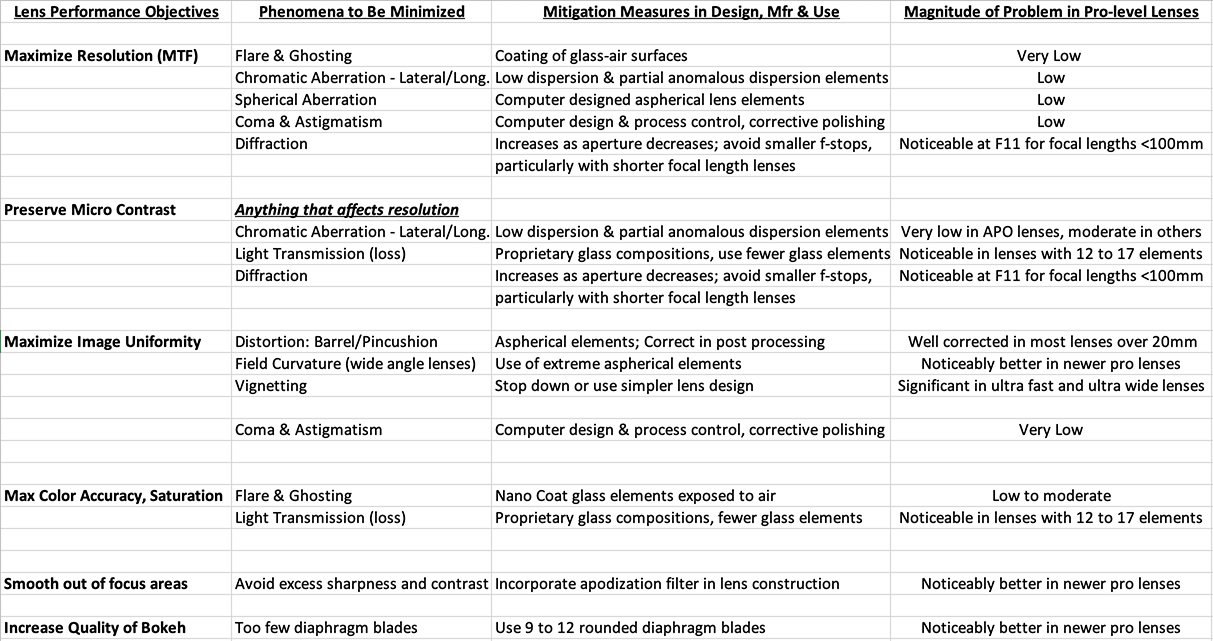
Industry Trends
Some of the above corrections are basically non-issues in today’s pro quality lenses. With recent jumps in sensor resolution, R&D resources have now tilted toward higher lens resolution and minimizing falloff at smaller apertures until diffraction becomes significant.
Faster lenses with maximum apertures of f1.2 and even f0.95 has also been an expanding market segment because of the popularity of low light photography and low light videography, particularly among younger photographers. To the extent that faster lenses require both larger glass elements and more of them, lens designers have had to find ways to offset negative impacts on IQ like lower light transmission and stronger vignetting.
For years, the resolving power of lenses exceeded the resolution of camera sensors. However, pixel densities of sensors escalated sharply in 2015 when Sony’s A7r M2 used a 42 MP sensor, Nikon continued using Sony sensors, and Canon developed its own higher MP sensors. This has reached a peak with Sony’s 61 MP full-frame sensor. It can be argued that Sony’s brilliant research in suppressing noise generation at higher pixel densities, and increasing internal data transmission speed, has changed the equation substantially. In any case, as of late 2019 there were very few lenses that offered sufficient resolving power to fully exploit the new sensor.
However, over the last nine months, a number of lens manufacturers brought new higher resolution lenses to market, but with highly differentiated product. This reflects distinctly different business models and strategies.
Sony’s commitment to mirrorless cameras was a bold move that has definitely cut into the D-SLR market. Lacking the extensive range of lenses offered by Canon and Nikon for their cameras, Sony was successful in steering the market toward a completely new system where they were on more equal competitive ground. Their strategy has worked well. But to make mirrorless cameras competitive they also needed to shore up their limited range of lenses, particularly in the wide and long ends of the focal length range. Most of Sony’s new lens introductions in the past 30 months were aimed in that direction with both GM lenses and several truly outstanding lenses in their G line.
Now, if you are Sony, charging higher prices for their GM lenses, which offer improved performance through newer and more effective technology, is a good business model. They also have the advantage of being a major player in driving the market toward higher resolution and higher image quality. Since 2018, Sony has delivered some outstanding lenses for its A7 cameras that are characterized by high edge-to-edge resolution, high clarity, clean saturated colors and low distortion. (In all lenses, contrast and resolution fall off with increasing distance from image center. The objective is to minimize rate of fall off and/or increase central resolution.)
Most of Sony’s newly released lenses have been at the wide and long ends of focal length range where they were weak. These lenses have received substantial acclaim from professional and serious amateur photographers alike
Nikon and Canon have no lack of high quality optics to support their cameras. However, the dominance of D-SLRs has been receding, and it is Nikon’s and Canon’s turn to play catch-up and expand their own fledgling mirrorless lines, which they are doing with moderate success. Meanwhile, independent lens manufacturers haven’t failed to notice Sony’s market penetration, and have been busy offering new lenses for the FE mirrorless camera mount.
Earlier, Sigma’s Art Lens series offered higher resolution while at the same time producing faster lenses to satisfy the tastes of younger buyers as previously mentioned. Much of this line was based on designs originally developed for D-SLR’s. Though still expensive, Sigma’s lenses are priced under Sony’s GM lenses. However, Sigma was betting on the market’s willingness to accept high weight and bulk in return for highly corrected fast lenses at somewhat lower prices, a strategy that appears to have worn thin. Consequently, Sigma broadened their Contemporary line, offering lighter, smaller, and lower priced, high resolution lenses which have notably smaller maximum apertures. Additionally some of their faster lenses are being scaled down in size and weight while still retaining their faster apertures. At the time of this writing, Sigma just announced their new 85mm f1.4 portrait lens which is almost a full pound lighter than their Art version.
Even before Sigma, Tamron (which is partly owned by Sony) recognized an under-supplied market for compact, high-resolution lenses at affordable prices. They capitalized on this by designing their lenses with more modest maximum apertures. The recent trend to offer slower lenses with higher resolution and lower prices is a nod to Nature photographers who prefer lower weight and expense, but still demand high IQ.
One consequence of increased demand for higher resolving lenses is growing interest in MTF charts which show how lenses perform in differentiating increasingly higher frequencies of paired black lines separated by a white space. The higher frequencies relate to higher resolution capability, and are measured at intervals from image center to the edges of the image. There are several good summaries of how MTF works that are worth reading on the Internet. The acknowledged guru of MTF is Roger Cicala who started and owns LensRental.com. He regularly runs thousands of MTF tests on hundreds of lenses and is a great source of information on how different lenses compare in resolving power. His blog on that site is a great resource.
A Neglected Lens IQ Factor?
Although the world seems to be rushing down the higher resolution path, there are a few photography enthusiasts who have raised a red flag. Their caution is that in the headlong rush to fill the growing demand for higher resolving lenses, some companies are not paying attention to another important IQ attribute, the ability to render differences in hue and tone in fine detail. This quality is popularly known as “micro-contrast”. A key aspect of micro-contrast is its ability to provide beautifully smooth transitions in varying colors and tones, even within small structures.
At, first this seems contradictory. If ability to resolve fine detail is increased, why wouldn’t micro-contrast also improve, or at least be preserved? As shown in the above chart, overall resolution can be increased in different ways some of which are less expensive than others. Reducing chromatic aberration is one of the more expensive corrections, and traditionally has required using one special glass element for each of the three primary colors to focus all three to converge precisely at the point of sharpest focus. But, it is correcting for chromatic aberration that increases a lenses ability to preserve micro-contrast. However, production economics may force a different mix of corrections.
The specific market segment for which a particular lens is intended will determine pricing and maximum manufacturing cost levels, which in turn will lead each lens maker to decide which materials and components to use to stay within budget. One manufacturer may elect to limit the use of special glass elements to correct some aberrations but offer more popular features in his lenses like auto-focus and weather sealing. If a lens-maker is going to maximize both resolution and micro-contrast the higher production cost will either push sales prices much higher or cause other features to be eliminated. Some manufacturers and photographers brush the importance of micro-contrast off. My personal experience is that this aspect of lens IQ is very real and visible.
My Own Quest for Increased IQ
Once I started using a Sony A7r M4 camera I joined the ranks of those pressing for higher resolution lenses. Some of the recent changes in my lens lineup were detailed in Part 1 of this 3-part article. Like others, my objective was to maximize IQ, and equated that largely with resolution. After researching alternatives more deeply, and more closely evaluating images taken with new lenses on my Sony A7r M4, I began to reach some different conclusions.
Ironically, it was Voitlander’s (Cosina) development of several high resolution lenses for Sony’s A7 line that caught my attention and broadened my understanding of lens IQ. I bought a Voigtlander 110mm f2.5 APO-Lanthar 1:1 macro lens simply because of its reputation for outstanding resolution, but was blown away by other qualities after studying my first exposures. What I observed was abundant micro-contrast, though I wasn’t aware of that term until some months later.
Cosina, a Japanese manufacturer of high quality optics, recently marketed a growing line of E-mount lenses for Sony cameras. They have manufactured lenses for Carl Zeiss, Nikon and other top companies, and have a penchant for classic design. Over 20 years ago, Cosina acquired the right to produce photographic equipment under the venerable Voigtlander name. Their primary thrust is to make finely crafted, all-metal, manual focus lenses with superior optics.
During the past three years, Cosina introduced three apochromatic lenses for Sony FE mount cameras. Termed APO-Lanthars, two of these are macro lenses, a 65mm f2.0 1:2 macro lens, and the 110mm 1:1 macro lens that I bought, both of which fully resolve Sony’s 61 MP sensor edge to edge. The third APO-Lanthar is a newly introduced 50mm f2.0 classic that is being called the best 50mm lens on the market in terms of both resolution and overall IQ, and equal to or slightly better than Zeiss Otus performance. In keeping with the designation Apochromatic, the three APO-Lanthars have been corrected to the point where chromatic aberration is almost non-existent.
Images from these lenses display an extra aesthetic quality due to their ability to reveal richer tonal and color variation within fine detail. In other words, there is more to fine resolution than just more sharply defined structure. Color and tonal variation in Nature is richer than we can usually observe directly. Theoretically, a lens with high resolving power should give us greater access to the “micro” world. The fact is that only a lens completely corrected for chromatic aberration can reveal the underlying richness of fine shifts in color and lighting.
This is a particularly important quality to me because I prize subtlety more than the superficial “pop” that is trendy today. There is a good argument that pop, or initial impact, sells and wins contests. But, it also tends to present a different reality than what is usually found in Nature, while ignoring the small-scale sparkle that helps make natural scenes so appealing.
So, I wound up adding all three APO-Lanthar’s to my lens lineup. They have quickly become my favorite lenses along with my Sony FE 135mm f1.8 GM lens. Ironically, many lens reviewers added the caveat that these are manual focus lenses that might turn potential buyers off. I thought about that for all of 30 seconds. But, the fact is that I don’t really use autofocus except with my longer focus lenses used for wildlife and action photography.
A subtle quality like micro-contrast is difficult to appreciate or even discern in small prints and screen images. I am displaying the following six 1000 pixel-wide images anyway. But the reader is invited to pull up larger files of these same images on my website www.camerastops.com to get a better idea of the difference.
In the following first image, pay particular attention to the different cloud colors and their transitions; the pure white walls of the house in the deeply shaded foreground and the fine detail and hues in the darker tones of the rock formations. Few lenses could handle this challenging color and tonal range this well. This is an excellent example of micro-contrast. The silhouetted tree in the left foreground is slightly out of focus because of the shallow depth of field.

The next three images were taken with the Voigtlander 65mm f2.0 APO-Lanthar Macro lens. The same control of color and tonal phasing in small structures can be seen despite being taken in harsh lighting conditions. In particular, the cactus flower shows excellent micro-contrast in both the lightest tones and the darker tones. The sunset in the third image is a high contrast image taken when the foreground was almost black. However, the most interesting thing is the rich range of color and detail in the small bright clouds contrasted against the dark sky.


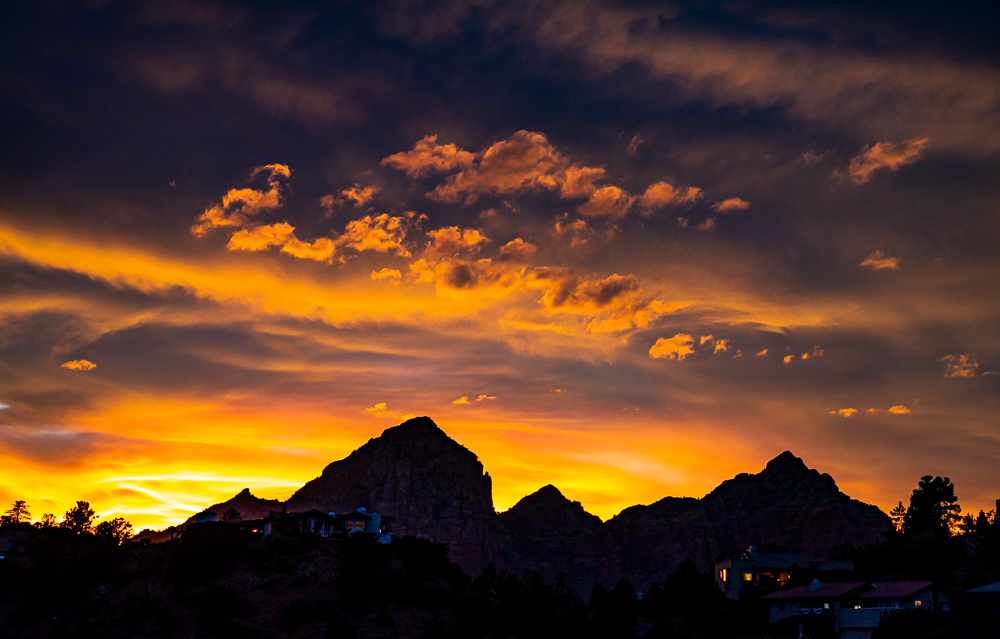
And, the following two images were taken with the Voigtlander 110mm f2.5 APO-Lanthar, and were the specific images that alerted me to the beauty of abundant micro-contrast. The view of Crimson cliffs is one that I have taken many hundreds of times. However, this image has varied lighting on the cliff face caused by broken clouds partially blocking the sun. This rock formation often appears to be a more monolithic medium orange tone. But, in this image, depending on light intensity, there is a rich range of yellow to orange-red colors and tones. This effect is supported with uniform sharpness and fine detail across the entire frame.
The second image is mostly about the turbulent Cumulus cloud over Carrousel Rock. Normally, it is difficult to bring out much structural detail in clouds as they are just water vapor after all. However, the ability of the this APO-Lanthar lens to show fine tonal shifts really captured the sense of the “boiling” movement within this massive Cumulus cloud. Note the crisp detail in the rock formation as well.


The capability of the three APO-Lanthar lenses has put me solidly in the same corner as those few writer/photographers who wrote about the importance of lens corrections that would preserve and enhance micro-contrast in landscape images, including urban landscapes.
My other lens selections
Four of the eight lenses that I use with my Sony A7r M4 are Sony lenses:
- the new Sony 20mm f1.8 G lens (High edge to edge resolution for G lens)
- the best in class Sony 24mm f1.4 GM lens
- the Sony 135mm f1.8 GM lens (the sharpest commercial lens ever made)
- the Sony 200-600mm f5.6-6.3 G zoom lens
The first three of these lenses are sharp across the entire frame. The 200-600mm zoom has a little fall-off toward the edges. But given that I use it for wildlife and action photography exclusively, this is not an issue for me. Furthermore, I often shoot with more margin on subjects in motion, and crop the edges off anyway.
But, to give Sony its due, the color and tonal rendition of these lenses are pretty darn good. The colors are accurate and reasonably saturated, and contrast throughout the images is well controlled. And though Sony doesn’t claim apochromatic designation for them, the images made with them are rich with reasonable micro-contrast. I have no complaints. The following images show why.






Perhaps the biggest surprise in this lens line-up is the Tamron 35mm f2.8 lens. It is the lightest of all my lenses, focuses to half life-size, is weather sealed, is sharp edge to edge, and now only costs $300. This has to be one of the most cost-effective lenses available. Image Quality is excellent, as can be seen below.
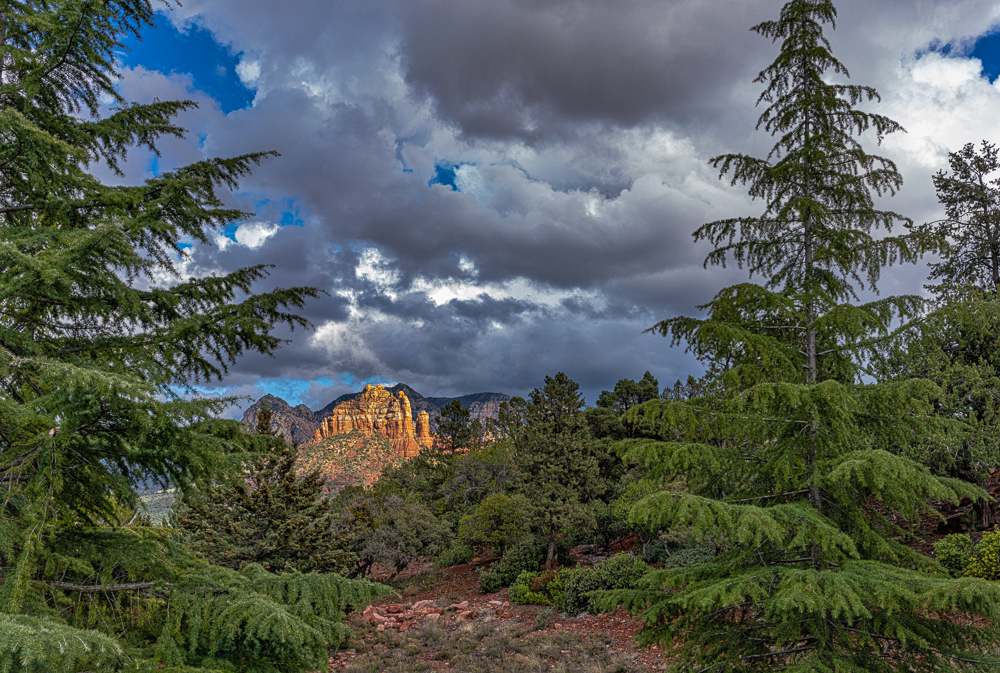
With the exception of the Sony 200-600mm zoom lens, my lenses are all primes, which is a consequence of seeking the highest resolutions to pair with the 61 MP sensor on the Sony A7r M4.
At the bottom of my Lens IQ Factor chart I listed two factors which have become more important to many photographers. Smooth renditions of de-focused areas has always been important to me. Rounded bokeh, or the out-of-focus highlights that take on the shape of the diaphragm opening isn’t a factor in the work that I do. But, the two factors are related. Today, there are a large number of recently developed lenses that offer both excellent bokeh and rendition of de-focused areas.
Among my eight lenses all but the Tamron 35mm f2.8 offer smooth treatment of de-focused highlights. The prime reason that the Tamron does not is that its maximum aperture is f2.8, which still generates considerable depth of field when focused at seven or eight feet or more. Generally, for wide angle lenses to produce strong separation between sharply focused subjects and de-focused background (or in some cases de-focused closer foreground) apertures of f1.8 and larger are necessary, preferably f1.4 or even f1.2.
Following are several images taken with my Sony 135mm f1.8 GM and Voitlander 110mm f2.5 APO-Lanthar lenses with narrow depth of field to illustrate good background blur.



Conclusion
Compared with the great variety of available pro level lenses, the preceding text is based upon a small cross section of recently introduced high resolution lenses, but offers some first hand experience and conclusions that hopefully will be useful to readers as they consider their own photography objectives and strategies. I would love to hear back from PhotoPXL participants regarding their own experiences and conclusions with newer 35mm format lenses. The issues associated with defining the characteristics of Image Quality are many, and often fuzzy. They deal with both measurable performance and subjective evaluation, and deserve continuing discussion.
Harvey Stearn
September 2020
Sedona, AZ
To see the scope and essence of Harvey Stearn's photographic art please visit www.CameraStops.com. Mr. Stearn began photographing Western landscapes and wildlife at the age of 13, spent 50 years pursuing his passion in the field and in the darkroom before fully converting to digital photography in 2002. He developed color prints as well as monochrome, but switched over to digital capture and editing in 2002. Though he was a top executive for two large scale land development and home building corporations, he always found time for his fine art photography which won many awards. His work was exhibited in art museums in Southern California and Arizona, and was also featured in billboard advertisements and published in magazines. Mr. Stearn served on the California Arts Council for nine years, including two years as Chairman and another two as Vice Chairman. In addition, he was the founding Chairman of the John Wayne Airport Arts Commission in Orange County, California. Mr. Stearn’s work was sold through Arizona galleries for 15 years. In recent years he wrote 33 illustrated articles for PhotoPXL.com and 14 articles for Luminous-Landscape.com. In 2013 he published a book entitled “In Search of the Old West” which has been widely acclaimed. He was a guest lecturer on photography on a cruise ship visiting Chile, Argentina, Uruguay and the Falkland Islands. His work was among the top 100 images printed in NANPA's Showcase publications in 2019 and 2020. Images have been edited and selected for two new books on Landscape photography which will be published in late 2024 and early 2025.






